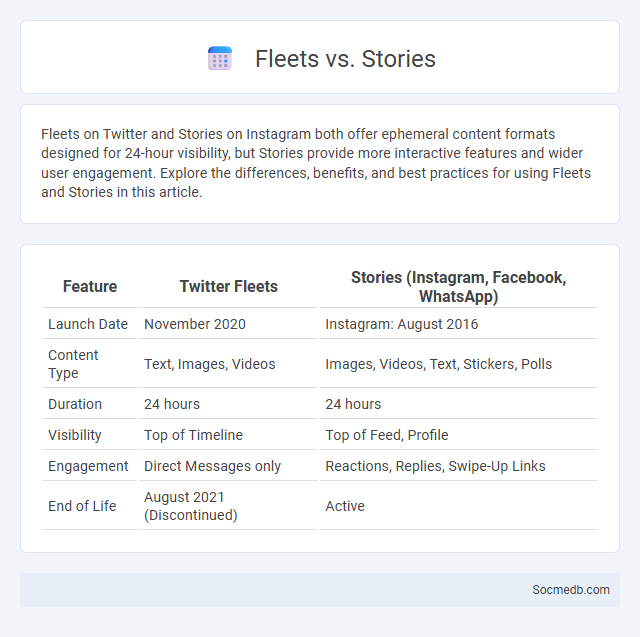
Photo illustration: Fleets vs Stories
Fleets on Twitter and Stories on Instagram both offer ephemeral content formats designed for 24-hour visibility, but Stories provide more interactive features and wider user engagement. Explore the differences, benefits, and best practices for using Fleets and Stories in this article.
Table of Comparison
| Feature | Twitter Fleets | Stories (Instagram, Facebook, WhatsApp) |
|---|---|---|
| Launch Date | November 2020 | Instagram: August 2016 |
| Content Type | Text, Images, Videos | Images, Videos, Text, Stickers, Polls |
| Duration | 24 hours | 24 hours |
| Visibility | Top of Timeline | Top of Feed, Profile |
| Engagement | Direct Messages only | Reactions, Replies, Swipe-Up Links |
| End of Life | August 2021 (Discontinued) | Active |
Introduction to Fleets and Stories
Social media platforms introduced Fleets and Stories as temporary content features designed to enhance user engagement by sharing moments that disappear after 24 hours. Fleets, first launched by Twitter, allow users to post text, images, or videos without the permanence of regular tweets, encouraging more spontaneous interaction. Stories, pioneered by Snapchat and popularized by Instagram and Facebook, offer a similar ephemeral format that boosts real-time sharing and fosters a sense of urgency and authenticity among users.
Definition and Purpose of Fleets
Fleets are temporary social media posts that disappear after 24 hours, designed to encourage more casual and spontaneous sharing. They serve the purpose of increasing user engagement by allowing You to share thoughts or updates without the permanence of traditional posts. This feature enhances real-time communication and fosters a more authentic connection with your audience.
Definition and Purpose of Stories
Stories on social media are short, temporary posts that typically disappear after 24 hours, designed to share moments in a more casual, authentic way. Their purpose is to engage audiences through ephemeral content that encourages real-time interaction, boosting user participation and brand visibility. Stories often feature multimedia elements like photos, videos, and interactive stickers, enhancing communication and emotional connection between users and followers.
Key Features of Fleets
Fleets on social media platforms offer ephemeral content that disappears after 24 hours, encouraging spontaneous and casual sharing. They support multimedia elements such as text, images, videos, and stickers, enhancing user engagement and creativity. Interactive features like reaction emojis and direct messaging promote real-time interactions and increased user participation.
Key Features of Stories
Stories on social media platforms offer ephemeral content that disappears after 24 hours, encouraging real-time, authentic sharing. Key features include interactive elements like polls, quizzes, stickers, and swipe-up links that boost user engagement and drive traffic. These visual narratives support photos, videos, and text overlays, enabling brands and individuals to create dynamic, immersive experiences.
Fleets vs Stories: Main Differences
Fleets on Twitter and Stories on platforms like Instagram and Facebook both offer temporary content that disappears after 24 hours, but Fleets focus on brief, text-centric posts with links to tweets, while Stories emphasize rich multimedia such as photos, videos, and interactive stickers. Your engagement on Fleets is often more conversational and tied to trending topics, whereas Stories prioritize visual storytelling and broader audience interaction through features like polls and swipe-up links. Understanding these distinctions helps you tailor content strategies to maximize visibility and user interaction on each platform.
User Engagement: Fleets vs Stories
User engagement on social media varies significantly between Fleets and Stories, with Stories typically generating higher interaction rates due to their interactive features like polls, questions, and swipe-up links. Fleets, Twitter's ephemeral content format, tend to foster more conversational engagement through direct replies and retweets, offering a unique way for You to connect with followers in a timely, authentic manner. Analyzing metrics such as views, replies, and share rates reveals that Stories drive broader visibility, while Fleets encourage deeper, community-focused interactions.
Brand and Marketing Impact
Social media drives brand visibility by enabling direct engagement with your target audience, enhancing brand loyalty, and fostering community building. Effective marketing strategies on platforms like Instagram, Facebook, and LinkedIn increase conversion rates through tailored content and data-driven advertising. Leveraging social media analytics helps optimize campaigns, ensuring maximum return on investment for your brand's growth.
Platform Availability and Support
Social media platforms offer extensive availability across various devices, including smartphones, tablets, and desktops, ensuring seamless access wherever you are. Many platforms provide dedicated apps for iOS and Android, optimizing user experience with regular updates and feature enhancements. Your engagement is supported by robust customer service and community guidelines that help maintain a safe and interactive environment.
Future Trends: Stories and Fleets
Stories and Fleets continue to dominate social media engagement by offering ephemeral, real-time content that drives user interaction. Platforms like Instagram, Snapchat, and Twitter emphasize Stories and Fleets for authentic, spontaneous sharing, increasing user retention and ad revenue opportunities. Emerging trends highlight AI-generated effects and interactive features, enhancing personalized user experiences and boosting platform growth.
 socmedb.com
socmedb.com